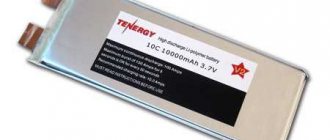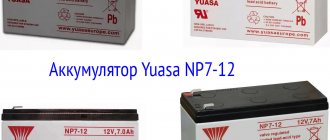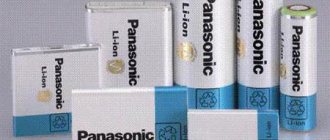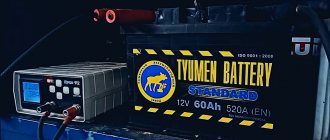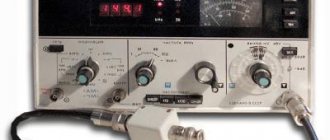The lead acid battery is the current source that powers the starter when the engine starts. The battery is the main source of energy. Among the advantages of this type of battery are an extended service life of more than 500 cycles, high power density, and cost. In addition to vehicles, lead batteries are found in standby and emergency power sources of stationary and mobile types.
The operating principle of a lead-acid battery is to convert chemical and electrical energy.
Principle of operation
The operating principle of a sealed acid battery is based on the electrochemical reaction of lead dioxide and lead, which occurs in an aqueous suspension of sulfuric acid. During charging, electrical energy is converted into chemical energy. When the battery powers an external source, chemical energy is converted back into electrical energy, powering the vehicle’s on-board network and starter.
The reaction rate and capacity are affected by the ambient temperature. If it increases, the maximum power increases. At the same time, the risk of element degradation increases and the tendency to corrosion increases.
Operating principle
The operating principle of a lead acid battery is as follows:
- The negative lattice reagent gradually disintegrates under the action of the electrolyte, forming lead ions. As a result of this decay, free electrons appear, which then enter the positive lattice of the electrode (via an external circuit);
- Lead ions react with the electrolyte to form lead sulfate. Due to its low solubility, it settles on the negative lattice.
- As a result, ordinary lead on the negative plate turns into sulfate.
- The positive electrode interacts less with the electrolyte than the negative electrode. Its main component, Pb02, reacts with water and is divided into positive and negative ions.
- The positive ones transmit the corresponding potential to the plate, where they merge with electrons. During the reduction reaction, Pb2+ is formed, which further reacts with the electrolyte.
- The resulting lead sulfate accumulates on the positive lattice, subsequently forming lead sulfate on its surface.
The battery receives electricity as follows:
- Near both plates the electrolyte contains a certain amount of water (H+, OH–) and lead sulfate (Pb2+, SO2/4)
- During the charging process, electrons move from an external power source from the positive terminal of the battery to the negative terminal.
- The incoming electrons restore the lead of the negative plate.
- The ions remaining after lead reduction and the H+ contained in the electrolyte combine to form H2SO
- On the positive plate, the incoming current knocks out 2 electrons from 2-valence lead, oxidizing it to 4-valence.
- As a result of subsequent interactions, Pb4+ combines with oxygen ions, reducing the material of the plus lattice.
- The remaining ions, reacting with each other, compensate for the density of the electrolyte.
Device Features
The battery consists of the following elements:
Lead-acid battery design.
- Frame. A block of dense composite material, usually propylene, that houses the batteries.
- Electrode. Flat gratings made of lead into which dioxide powders are pressed. The special coating increases the battery capacity.
- Separate envelope. Material that protects the battery from short circuits. It insulates gratings, plates of opposite polarity. As a rule, a lead-calcium alloy is used in production, which has minimal self-charging.
- Exit holes.
- Terminals. Contact blocks through which the battery communicates with the generator and starter.
- Density indicator and charge. A small window that allows you to track the current battery charge level.
Removing batteries
Before you begin removing the battery from the vehicle, you must read the repair manual. Please note that the instructions will differ depending on the brand of battery.
- Remove the key from the ignition.
- Remove the protective cap from the battery casing and terminal covers (they are sometimes attached).
- Disconnect the battery cable clamp from the negative terminal first (if you disconnect the battery cable clamp from the positive terminal first and it accidentally touches the body, it will cause a short circuit.
- Then disconnect the other three battery terminals.
- Disconnect the connecting cable between batteries 1 and 2.
- Then remove both fasteners.
- Remove both batteries from the compartment.
Battery Installation
Before proceeding with installation, please read the repair manual. Each brand has its own instructions.
- Install new batteries.
- Clean the terminals and clamps.
- Install the jumper cable with clamps to battery negative terminal 2 (rear battery) and battery positive terminal 1 (front battery). Pay special attention to the terminals as the plus terminal has a larger diameter than the minus terminal. Both terminals often taper at the top.
- Install the clamp for the positive terminal 2.
- Then install the clamp for negative terminal 1.
- Lubricate the battery terminals and clamps with grease to prevent corrosion.
- Place the protective caps on the pole covers (if equipped).
- Place the protective cover on the battery case.
- Insert the key into the ignition.
Varieties
Lead-acid batteries are divided according to the type of electrolyte and purpose. In the second case, the liquid can be absorbable, liquid, or gel-like. Most models in the budget, mid-segment have a liquid medium of sulfuric acid solution.
In more expensive models, the electrolyte is retained in a special microporous material. Such batteries have an increased effective mass and, as a rule, are installed in a vehicle with a regenerative braking or stop-start system.
According to their intended purpose, car batteries are:
- Traction. When it is necessary to provide the device with constant energy. As a rule, tractors, electric cars, and forklifts are equipped with such batteries.
- Starter. Used to start the engine when short-term peak power is required.
Detailed classification of lead-acid batteries.
Where are they used?
The solutions allow you to work with large peak power loads. Therefore, the scope of use of batteries is very wide. Installation possible:
- On all starter and a number of traction engines of cars.
- On motor vehicles: mopeds, motorcycles, ATVs, scooters.
- On boat motors.
- On aviation technology.
- Solutions with liquid electrolyte are more often used as starters, as buffers, and also on complex equipment, including aviation, they mainly use solutions absorbed on a separator (using AGM technology).
Characteristics
When choosing a battery, car enthusiasts look at the following parameters:
- Nominal capacity. A parameter in Ah that determines the amount of electricity that the model can transmit.
- Starter current. The ability of a car battery to efficiently deliver current at a given temperature. As a rule, the indicator is determined at a temperature of -18°C, with a measurement duration of 30 seconds.
- Reserve capacity. The maximum time during which the battery will supply a current of 25 Amps to a final voltage of 10.5 Volts.
Cyclic and buffer operation of the battery
On some batteries, the case shows the maximum charging current and two voltages, or actually two voltage ranges.
The permissible cycle voltage applies to cyclic operation, that is, when the battery is charged for several hours and then discharged for a longer or shorter time. An example would be an electric scooter battery that operates cyclically.
On the other hand, standby mode is the so-called buffer operation, when the battery is always energized and ready for use. A typical example is a UPS. Another example is a backup power supply for alarms. Then the battery is constantly connected to the charger - the power supply, so the voltage is lower than in cyclic mode.
As shown in the photo, the voltage during float mode should be 13.5 - 13.8 V, in cyclic mode the final charge voltage can be 14.4 - 15.0 V. Since a 12 volt battery has six cells, this gives 2 .25 – 2.30 V/cell in buffer mode and 2.4 – 2.5 V/cell in cyclic mode.
Terms of Use
Lead-acid batteries are sensitive to critical temperatures. As external environmental parameters decrease, the properties of the battery deteriorate, but unlike other types of batteries, the loss of power is not so significant, which explains their prevalence in the automotive industry. Tests have shown that when the external temperature decreases by 1 degree below +20, the capacity decreases by one percent. That is, at -20 the battery degrades by about 40%.
Dependence of battery capacity on temperature.
This behavior is due to a decrease in the rate of the chemical reaction. Therefore, manufacturers in northern latitudes recommend leaving the car in a heated garage or heating the battery with a special heater provided in the vehicle. There are also special models with an integrated heating system.
In cold weather, the density of the electrolyte should be monitored. If it is below 1.10 g/cm3, ice crystals will form, which will lead to deformation of the lead plates and loss of warranty.
Battery overcharge protection
Acid batteries have the very important advantage that the voltage reflects the state of charge. To avoid overcharging, simply do not exceed the voltage specified in the data sheet.
The charging current is usually in the range of 0.1 C ... 0.3 C (in some cases up to 0.4 C), which is numerically 10 ... 30% of the battery capacity (C), expressed in ampere-hours. For example, for a battery with a capacity of C = 70 Ah, a current of 0.1 C is 7 A, and 0.4 C is 28 A.
The maximum charging current of a given battery is usually indicated - for example, the maximum charging current of conventional standard 12-volt car batteries is 3.6 A, that is, 0.3 C (30% of the numerical value of the capacity).
Charging at 0.3 C for 3 hours 20 minutes will theoretically provide the battery with its rated charge (C). But due to the insufficient efficiency of the battery, the resulting charge must be greater than C.
Constant current charging over time may be acceptable at low charging current, well below 0.1 C (10% capacity by quantity). But this can also lead to gas formation. The problem is that the voltage of a lead battery increases, and with a significant current it will exceed the permissible level, which will cause intense gas emissions.
Theoretically, you can use any primitive rectifier made from a light bulb and diodes, monitoring the voltage with a voltmeter and turning off the charge when the voltage rises to the limit value. In practice, this method of control will not work. Human participation must be excluded (so as not to forget to disconnect the battery). In addition, many manufacturers report that AGM and gel batteries should be charged with a "smooth" constant current with as little ripple as possible.
Therefore, to interact with gel and AGM batteries, special chargers are used, which are essentially stabilizers with a certain voltage, usually also containing a current limiter circuit.
The most popular CCCV charging procedure
The circuit diagram of a 1 Amp charger with a current limiter is shown in the figure below. At the initial charging stage, the battery is charged with a constant current determined by the value of resistor R3 (I ~ 0.7 V / R3). When the voltage drop across R3 approaches 0.7 V, T1 begins to open and the voltage drops enough to maintain a constant current.
Charger circuit with current limiter
During this initial phase, the current limiter in the charger is activated and the voltage gradually increases. When the voltage reaches the value determined by R1 and R2 + P1, the charger begins to work as a regular voltage stabilizer with the LM317 unit in the simplest mode. The voltage no longer increases, which means that when the battery is almost fully charged, the current automatically begins to gradually decrease, almost to zero.
Car battery charging characteristics
The process of this most popular charging procedure, called CCCV (Constant Current, Constant Voltage), is shown in the figure. Preventing excessive voltage increases effectively prevents the formation of gases. The CCCV method also charges lithium batteries (Li-Ion, LiPo, LiFePO4), only the permissible currents and voltages differ.
The main discussion was about the maximum charging current. It is worth noting that the catalogs show the characteristics of such a charge at a relatively low current of 0.1 C. An example is in the figure. At this current, the charging time is 15 ... 20 hours, which can sometimes be unacceptably long.
You can reduce the charging time by increasing the current to the maximum value according to the battery documentation. Then the charging time will be 1.5 ... 2 times less than it could be when dividing the nominal capacity C by the standard charging current.
Advantages and disadvantages
The popularity of these types of batteries is explained by the following factors:
- reliability;
- low self-discharge;
- ease of maintenance (some models do not require topping up electrolyte or additional service);
- affordable price, due to low cost.
In addition to the advantages, lead-acid batteries are not without their negative aspects:
- for long-term storage, the battery must be fully charged;
- poor tolerance to deep discharge;
- limited number of charge-discharge cycles;
- the components from which the battery is made are harmful to the environment;
- The battery must be charged correctly. If the voltage level is violated, there is a risk of overheating of the cans;
- unstable operation at extreme temperatures. If you do not follow the signs indicated on the information sticker, the car will have difficulty starting in winter at critical temperatures.
Life time
A high-quality battery, manufactured in compliance with technology, will last 2-3 times longer than cheap products from a dubious brand with a 6-month warranty. This means the same types of batteries and the same load conditions on them.
A mid-price battery with a 2-year warranty at moderate starting loads will cover about 100 thousand km or last 3-5 years. Operation in more intensive modes, for example, in a taxi, will reduce the service life by at least half. If we add to this work mainly in low temperature conditions, careless attitude to maintenance, and several full discharge cycles, then even a high-quality battery is unlikely to last more than a year.
Exploitation
In order for lead-acid batteries to last longer than the stated warranty period, certain operating rules must be followed.
Job
If the battery is serviceable (the banks are opened to add electrolyte), when driving on an uneven surface, a slight seepage of electrolyte occurs from under the caps into the housing. To prevent deep self-discharge, it is recommended to regularly wipe the housing with household liquid diluted in water. soap or soda solution. Thus, the electrolyte is neutralized.
The electrolyte level should also be monitored, preventing the plates from being exposed (in this case, self-discharge increases and the batteries oxidize).
Storage
Dependence of battery shelf life on ambient temperature.
When removed, acid batteries can only be stored with a full charge. If the temperature in the box is below -20°C, the battery should be recharged annually for 48 hours (voltage 2.45 V). At room temperature in the storage location, it is enough to recharge every 8 months for 8-12 hours.
The surface of the battery should be kept clean. This prevents the battery from self-discharging, which is fraught with loss of capacity associated with the formation of high-density sulfide, which reacts less well.
If the vehicle is not used in winter, you should prepare the battery by following these steps:
- carry out a full charge in accordance with the manufacturer's recommendations;
- Apply grease to the positive terminal to prevent moisture absorption on the surface;
- store the battery at a temperature within 0 -10 °C, excluding freezing of the liquid inside the cans.
If you need to travel in cold weather, you should move the battery to a heated room, and within 7-9 hours (for example, overnight) it will be in a condition suitable for starting the engine.
Disposal rules
Under no circumstances should you disassemble the battery yourself in an attempt to obtain lead for recycling at home. Like other batteries, a lead-acid battery must be taken to a specialized service center. As a rule, they operate at the point of purchase. Industrial recycling may provide a discount on the purchase of a new battery.
Capacity indicator
The standard way to check battery capacity is considered to be a test discharge. A fully charged battery is discharged with direct current. The current consumed must be a multiple of the battery capacity (the optimal ratio is 1 to 20). For example, with a nominal capacity of 60 Ah, a lead acid battery is discharged with a current of 3 A for 20 hours.
The method described above is quite labor-intensive and complicated, and the battery cannot be used during measurements. To quickly test a lead-acid battery, you should use special devices such as “Load fork” or similar capacity indicators.
Recycling
The lead contained in batteries is a toxic heavy metal that can cause serious damage to the environment. Lead and its salts formed as a result of battery operation must be disposed of in an industrial environment.
Battery recycling takes place at recycling plants that have all the necessary equipment.
Disposal rules
Order special equipment on our website: Special equipment rental in Russia
The average service life of a lead-acid battery for a car is from two to five years or up to 130-150 thousand kilometers. Failure to follow the rules discussed above leads to rapid failure of the device. Used lead batteries cannot simply be thrown into the trash. There are several ways available here:
- Delivery to specialized collection points.
- Exchange in the store for a new battery and receive a discount.
- Transfer to private individuals for a fee. But you need to take into account that in this case there is a high risk of getting less money, and the individuals themselves rarely have a license to collect hazardous components.
Lead-acid truck batteries require special attention due to harsh operating conditions. To extend the service life, it is necessary to follow the maintenance rules, monitor the condition of the battery and recharge it in a timely manner.
How to choose a battery
The choice of models presented in stores is large. To buy a lead-acid battery, it is recommended to pay attention to the following nuances:
- Size. When selecting a battery, the size is important, which should correspond to the niche in the engine compartment.
- Polarity. The location of the terminals of the new battery and the old one must match.
- Brand. Experts recommend choosing a battery for a car from a well-known manufacturer, which guarantees the quality of the product within the stated period.
- Type. Serviced or unserviced. In the second case, the battery does not require additional care, but if it is deeply overdischarged, it cannot be regenerated.
- Declared current. The higher the parameter, the lower the internal resistance, the better the model.
Due to its consumer characteristics, a lead-acid battery is practically the only option for installation in a car. At the same time, manufacturers offer hundreds of options, differing in price, technical characteristics, and aimed at different customers.
Systematizing knowledge, acquiring skills: distance learning
So, you have become acquainted with the theory regarding batteries, classification, recovery methods, charging, but want to study the topic deeper, systematize your knowledge on this issue as much as possible, learn how to work with the battery in practice, test your knowledge?
Great! The ELECTUDE online training system for mechanics, electricians and diagnosticians will help you. The huge advantage of the online platform is that it is maximally focused on an integrated approach (basics of physics + practice-oriented materials), and you can get not just knowledge, but also specific skills, and the knowledge assessment system in the form of tests will help you really evaluate, what topics still need to be worked on, at what pace to move forward.
Below we provide screenshots and descriptions of the modules we translated into Russian, which directly relate to the topic discussed above.
Study, take a closer look at the ELECTUDE system and find a new source for yourself, not just for gaining knowledge, but for step-by-step development of practical skills. Indeed, in addition to the basic modules, the system has a special virtual simulator. It will help you “pump up” to the fullest. The system is excellent for distance learning and self-study.
Acid batteries; so that it is no longer disgusting to read what people write about them
I accidentally saw an article with comments on it, and anger began to boil inside me about the illiteracy of people in the field of acid (lead in common people) batteries that I could not stand it and decided to write to “geeks” (to be a geek, as it turns out, it’s not enough to buy an expensive phone) a short article about batteries. With consideration of those mistakes that constantly bother my eyes and cause a righteous desire to correct them. Let's start with the name. I very often see that the three letters A-K-B are used to describe everything that can be charged, absolutely any battery. People especially like to call Li-ion batteries with three letters. In fact, AKB is an abbreviation for Rechargeable Acid Battery. They mean only one type of battery - lead acid. From a modern point of view, this name causes some cognitive dissonance because at the moment the meaning of the word “battery” is galvanic cell that cannot be charged switched to the word “battery”. And it turns out that because of the word “rechargeable” it is a battery that can be charged, but because of the word “battery” it is as if it is a battery that cannot be charged. In reality, a battery is simply a chain of galvanic cells and only has a root in common with the word “battery”.
Next, let's move on to some myths, namely the main myth - the battery for a car has some significant differences from the battery for a UPS. And so you can’t use them both here and there. From a chemical point of view, any battery is absolutely the same
. How are they arranged? Very briefly - if the battery is charged, then one electrode is a lead grid with PbO2 paste applied to it, the second is the same grid with sponge lead paste. The electrolyte is a solution of sulfuric acid. During the discharge process, PbO2 is reduced and interacts with sulfuric acid to form PbSO4. Lead on the other electrode is oxidized and again forms PbSO4. At the end of the discharge we have both grid plates filled (more or less) with lead sulfate. When charging a battery, electrolysis occurs and lead sulfate again produces dioxide and metallic lead. Of course, here it is necessary to emphasize that the electrodes are not equal and their polarity should not be confused because Even at the production stage, appropriate additives are introduced into the electrode coating to improve their performance properties. Moreover, additives that are beneficial for one electrode are harmful for another. In very old times, somewhere at the beginning of the last century, in the conditions of simple batteries, it was probably permissible to reverse the polarity of the battery by mistake or for some purpose and it worked for some time after that. I doubt that it is acceptable now.
There are 6 such cells in a 12V battery, and 3 in a 6V battery. etc. Many people are confused by the battery voltage. Moreover, the values of the nominal voltage, charge, discharge. On the one hand, the batteries are called 12V (and 6V, 24V are also available, in my opinion, even 4V are occasionally found), but on the case of the same batteries for UPS, the manufacturer indicates a voltage higher than 13.5V.
For example:
Here we see that in forced mode the charge
maybe as much as 15V.
The voltage curve on the battery will explain everything:
On the left we see the voltage for a battery of 12 cells (24V nominal), 6 (12V nominal) and, most usefully, for a single cell. Areas of unwanted voltages during discharge/charge are also marked there. From the curve we can draw conclusions:
1 Voltage 12V, 24V, etc. are nominal and show only the number of galvanic cells (by dividing by two) in the battery. This is just a name for convenience.
2 The charging voltage can reach 2.5 V/cell, which for a 12V battery corresponds to 15V.
3 The voltage of a charged battery is considered acceptable at a value of 2.1-2.2 V/cell, which for a 12V battery corresponds to 12.6-13.2V.
Theoretically, the battery can be charged to 2.4 V/cell or even slightly higher, however, such charging will negatively affect both the condition of the electrodes and the electrolyte concentration. One day, before scrapping, I easily charged a 12V battery to a voltage of approx. 14.5V (I don’t remember the exact value).
So, the author of the article with which I started, decided that the charging voltage of a car battery and a battery from a UPS are different. This is not true, they have the same type of electrodes and the same concentration of sulfuric acid in the electrolyte (selected experimentally a long time ago to provide maximum voltage and minimum self-discharge). However, what happens in the battery, why can’t it be charged at too high a voltage?
Why do you need to add water to a car battery, but you don’t need to add water to a battery from a UPS? These questions allow us to smoothly move into the area of stress of water decomposition. As I wrote above, when charging a battery, electrolysis occurs. However, not all the current is spent on converting PbSO4 into PbO2 and Pb. Part of the current will inevitably be spent on the decomposition of water, which makes up a significant part of the electrolyte:
2H2O = 2H2 + O2
Theoretical calculation gives a voltage value for this reaction of ca. 1.2V. Let me remind you that the voltage on the cell during charging is obviously more than 2V. Fortunately, water begins to actively decompose only above 2V, and in industry, to obtain hydrogen and oxygen from it, the process is carried out at 2.1-2.6V (at elevated temperatures). Be that as it may, here we come to the conclusion that at the end of the battery charging process there will inevitably
the process of decomposition of water in the electrolyte into elements occurs. The resulting oxygen and hydrogen simply evaporate from the reaction sphere. There are the following myths about them:
1.
Hydrogen is extremely explosive! You overcharge the battery and at the very least you will lose the room where it was!
In fact, negligibly little hydrogen is released during the electrolysis process compared to the volume of the room. Hydrogen explodes at a concentration of 4% in air. If we assume that electrolysis is carried out in a room measuring 3*3*3 meters or 27 cubic meters, then we will need to fill the room with 27*0.04=1.1 cubic meters. hydrogen. To obtain such an amount of H2 it would be necessary to completely decompose approx. 49 moles of water or 884 grams of it. If anyone has observed electrolysis, they will understand how much this is. Or let's try to go to time. With a standard charging current for large batteries of 6A, Faraday's equation gives the time required to produce this amount of hydrogen as much as 437 hours or 18.2 days. To fill a room with hydrogen to an explosive concentration, you need to forget about charging for 2 and a half weeks! But even if this happens, the concentration of sulfuric acid will simply increase until its solution acquires too high a resistance for the measly 12V charging and the current becomes negligible. And the hydrogen will simply evaporate.
Explosions very rarely occur directly in the housings of large batteries due to the fact that the released hydrogen for some reason cannot leave the confined space. But even in this case, nothing terrible happens - most often the explosion is only enough to cause a slight deformation of the upper part of the body, but not to break the lead connections. And the battery can still continue to work even after such damage.
2.
Electrolysis can produce deadly poisonous and no less explosive than hydrogen, hydrogen sulfide!
Not ours, periodically I came across a myth in English-language posts. Theoretically, of course, it is possible to apply such a high voltage and create so. such a high current that the process of reduction of sulfate ion will begin at the cathode. The voltage for this will be sufficient, and the reduction products will not have time to diffuse away from the electrode and the reduction will proceed further. But charging within ten to three volts and with a current limit of 6A is hardly capable of this. Once, I observed the process of reducing sulfate to SO2, yes, it is possible; classmates mistakenly did something wrong during the experiment. But this is very rare because... there the concentration of sulfuric acid was noticeably higher than that used in batteries, the design of the electrode and its material were different and, naturally, the voltage and current were exorbitant. And SO2 is not H2S.
3.
During electrolysis, arsenic and antimony from the grating material will be reduced to poisonous arsine and stibine!
Indeed, the gratings contain relatively a lot of antimony; there is probably no arsenic in modern gratings at all. When the battery is operating, the grid on which recovery occurs, i.e. cathode cannot be destroyed. Even if stibine were somehow released, it would immediately interact with PbSO4, reducing it to metal.
However, there is some practical trouble here. Hydrogen and oxygen gases can
carry droplets of electrolyte along with them, creating an aerosol of sulfuric acid. An aerosol of sulfuric acid, even concentrated, is not dangerous for humans and simply causes a cough. However, sulfuric acid is a nightmare for fabrics and paper. If even a small amount of sulfuric acid gets on clothing, holes will certainly appear there or the fabric will tear in that area. In weeks, if there is a lot of acid, in a month, but the clothes will rot.
So you shouldn’t be afraid of gas emissions from a household point of view, or you should, but you need to focus specifically on the aerosol of sulfuric acid.
So, water has begun to decompose into hydrogen and oxygen, there is less and less of it in the electrolyte, what next? If this is a battery in which the electrolyte is simply poured in the form of a layer of liquid, then an increase in self-discharge will begin due to an increase in the concentration of sulfuric acid. It is interesting that this will be accompanied by a slight increase in voltage (the acid concentration increases) on the cell. That is why car owners must constantly monitor the concentration of sulfuric acid in their batteries (using a hydrometer) and add water there. The procedure for adding water is a necessary part of the maintenance process.
any battery. Except for one type, and we'll talk about that now.
Having a battery in which a layer of liquid, caustic towards metals, dangles is of course inconvenient, and therefore attempts to get rid of the liquid directly were made a long time ago, starting almost in the first half of the 20th century. By the way, it’s not like a layer of sulfuric acid was splashing around the electrodes. In reality, it is well distributed between the electrodes and the separators surrounding them, even in cheap models. So the first option was to use fiberglass. Simply surround the electrodes with fiberglass impregnated with sulfuric acid and most problems will be solved. This type of battery is called AGM (absorbent glass mat) and the vast majority of such batteries are for UPS. Although such small form factor batteries are often positioned as those that can be used in any position, we cannot completely agree with this. Opening the cover of a standard cheap AGM battery shows that there are no special covers there, and therefore, only capillary forces keep the electrolyte from leaking out. I’m almost sure that if you drive an AGM battery upside down, then after one charge, sulfuric acid will flow out of it under gas pressure.
The second common type is more interesting, this is the so-called. gel batteries. And they are obtained thanks to the following. If soluble silicates are acidified, silicic acid will be released:
Na2SiO3 + H2SO4 = Na2SO4 + SiO2
+ H2O
If the original silicate solution is of poor quality, the silicic acid will precipitate as a glassy mass, but if it is pure enough, the silicic acid will precipitate as a nice piece of uniform, translucent gel. The method for producing gel batteries is based on this - simply adding silicates to the electrolyte causes it to harden into a gel-like mass. Accordingly, there is nothing left to leak from there and the battery can really be used in any position. The process of gel formation itself does not increase the capacity of the battery or improve its qualities, however, manufacturers use it in the production of the highest quality models, and therefore these batteries are of high quality and greater capacity. It is interesting that in both cases the electrolyte carrier is SiO2 in one form or another.
Both types of batteries are combined into the glorious VRLA type - valve-regulated lead-acid battery, which is used in UPSs. Formally, they are considered maintenance-free and can be used in any position, but this is not entirely true. Moreover, many have already encountered the effect when literally a few ml of water brings back to life a seemingly dead battery from a UPS. This happens because these batteries are not at all immune from electrolysis of water in the electrolyte, and therefore from drying out. Everything happens exactly the same as in large batteries. But the most expensive and cool maintenance-free batteries contain a catalyst for the recombination of released gases back into water, and now their case is truly completely sealed. Please note that AGM and GEL type batteries can be truly sealed and maintenance-free, but they may not be and may not contain a catalyst for the recombination of oxygen and hydrogen. Then, despite the seemingly advanced design, the user will have to either buy new batteries more often or add water using a syringe.
I would like to add a few words about discharge modes. Battery manufacturers indicate the maximum allowable current for a particular model, but you need to understand that a battery is simply a mixture of chemicals and the emf is generated exclusively chemically. This is not a capacitor which, by electrohydraulic analogy, can be compared to some kind of mechanical vessel (with a flexible membrane). Although batteries can produce very high currents, in reality they operate best at low currents, both in discharge and in charge. Therefore, UPSs designed to charge small batteries will charge them in the most gentle mode when working with large ones. However, over the course of more than one day. It is interesting to note that the higher the power of the UPS, the more batteries the manufacturer prefers to assemble in series. Everything is logical here - small batteries withstand high discharge currents very poorly.
To sum it up:
1. Small-sized and large-sized batteries are identical in design.
2. For the vast majority of batteries of any size, adding water is a necessary part of routine maintenance.
3. Only a few of the expensive battery models contain a gas recombination mechanism and can be called truly maintenance-free.
4. The hydrogen itself, which is released during charging (which is equal to constant operation in a UPS) of the battery, is not a significant threat or problem.
5. You need to work very carefully with the battery, carefully avoiding spilling even the slightest drops of electrolyte, or you will lose your clothes.
6. Discharge and charge with low currents are the most preferred modes of battery operation.
conclusions
There is no consensus on which battery is better, lead acid or lithium. Despite the rapid development of lithium technologies, batteries are not losing ground and are still used to equip warehouse equipment, golf carts, UPS and other devices. But due to objective advantages, lithium batteries are increasingly becoming a priority.
When choosing the optimal power source today, lithium iron phosphate batteries are in the lead. They have a stable chemical structure, a wide range of operating temperatures and a long cyclic life, charge quickly, and are not afraid of deep discharge and harsh operating conditions. Such batteries are often used as traction batteries for electric vehicles, outboard motors, cleaning and warehouse equipment.
The previous article on our blog provides recommendations for using lithium titanate batteries.

